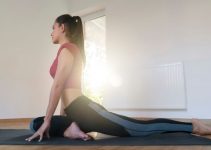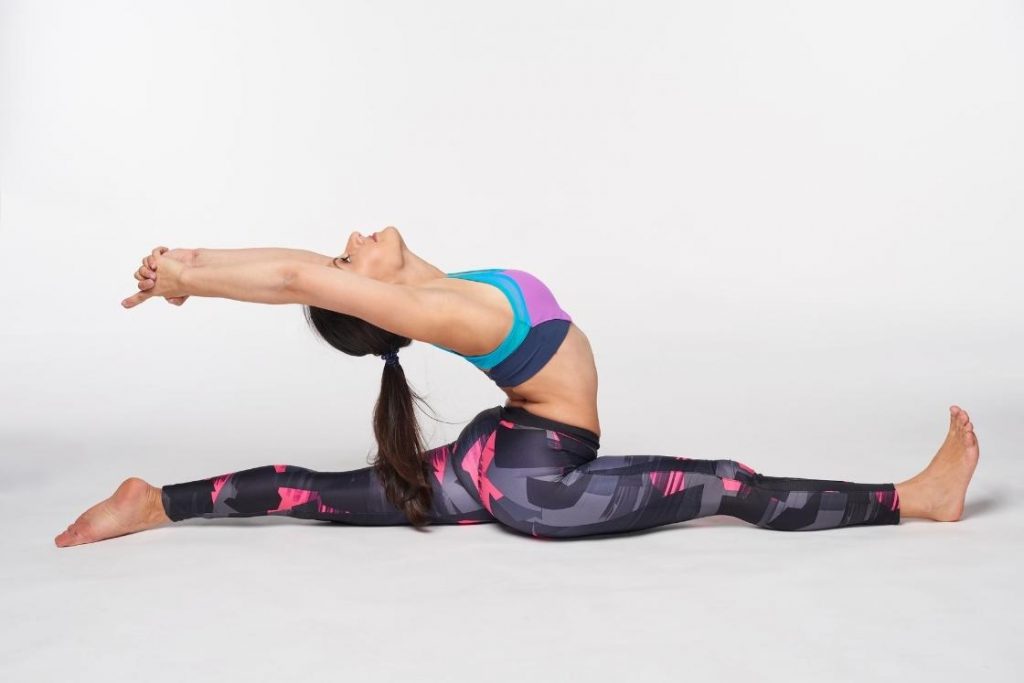
| Sanskrit | Hanumanasana |
| Pronunciation | hah-NU-mahn-AHS-anna |
| Common | Splits Pose, Front splits pose, Monkey Pose, Dragon Splits Pose |
| Type | Seated |
| Level | Advanced |
| Stretches | Hamstrings, Quadriceps, Calves, Groins, Pelvis, Hips, Psoas |
| Strengthens | Back, Spine, Pelvic floor, Abdomen, Shoulders, Core |
Hanumanasana, commonly known as Monkey Pose, is a revered yoga posture that embodies strength, flexibility, and spiritual devotion. Named after Hanuman, a heroic figure in Hindu mythology known for his unwavering loyalty and extraordinary abilities, this pose symbolizes the qualities of courage and humility.
Hanumanasana requires practitioners to gracefully move into a deep split, aligning the body in a way that not only stretches the muscles but also invites a sense of mindfulness and balance. When yogis engage in the exploration of this pose, they embark on a journey of self-discovery, connecting with the essence of Hanuman’s devotion and embodying the virtues of physical and mental resilience
Follow this step-by-step guide to gift your legs the enhanced flexibility and strength.
Story
The pose is named after Hanuman, the Monkey God. The story behind it can be traced from the epic Ramayana.
There is an incident where Sita was abducted by Ravana to Sri Lanka, then Rama took help from Hanuman to rescue her back. Hanuman went to Sri Lanka making a giant leap from South India to Sri Lanka.
This gigantic heroic leap by Hanuman is interpreted as the front split made in the pose, hence named after him. Hanuman was described as a monkey in the scriptures, therefore this asana is also referred to as monkey pose.
As the legs attain a full split, therefore hanumanasana targets the hamstrings, groins, and hip flexors. Also, the core muscles and quadriceps are actively engaged holding the pose.
Hanumanasana(Monkey Pose) Practice Guide
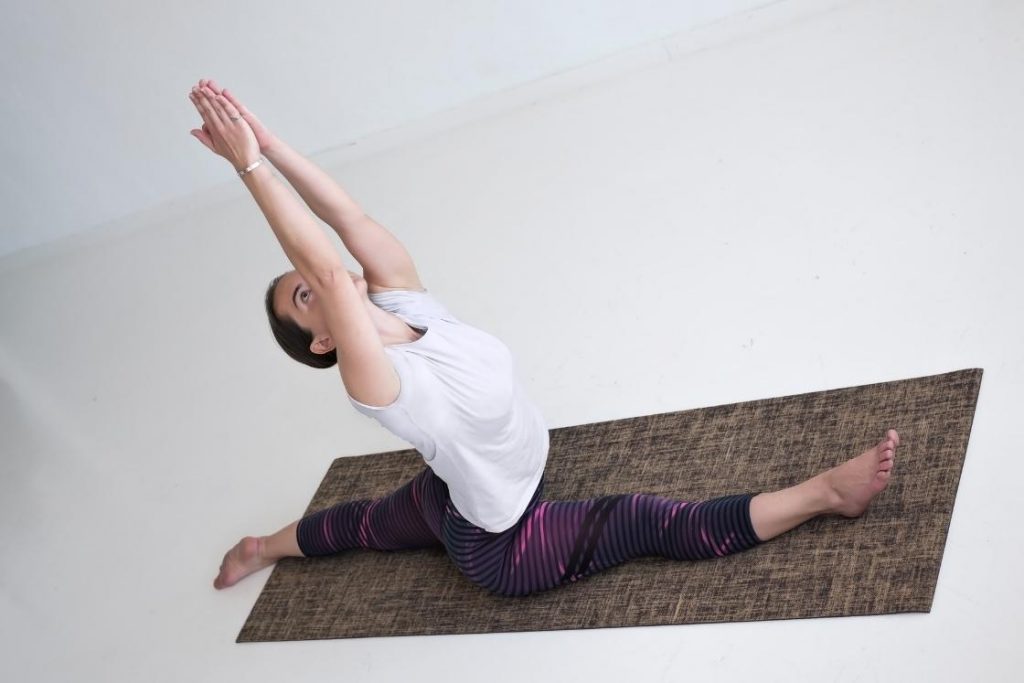
Precautions & Contraindications
- Do not attempt hanuman asana if you have a slipped disc or hernia.
- People suffering from sciatica must refrain from this pose.
- Do not try this pose with a dislocated hip joint.
- Avoid this pose there is an injury in the hips, pelvis, hamstrings, knees, and ankles.
- Pregnant women are advised not to practice Hanuman asana.
Preparatory poses
- Seated Forward Bend (Paschimottanasana)
- Head-to-Knee Forward Bend (Janu sirsasana)
- Wide-Legged Standing Forward Bend (Prasarita Padottanasana)
- Supine Thunderbolt Pose (Supta Vajrasana)
- Reclining Hand-to-big-toe Pose (Supta Padangusthasana).
- Hero Pose (Virasana)
- Reclining Hero Pose (Supta Virasana)
How to Do Hanumanasana (Steps)
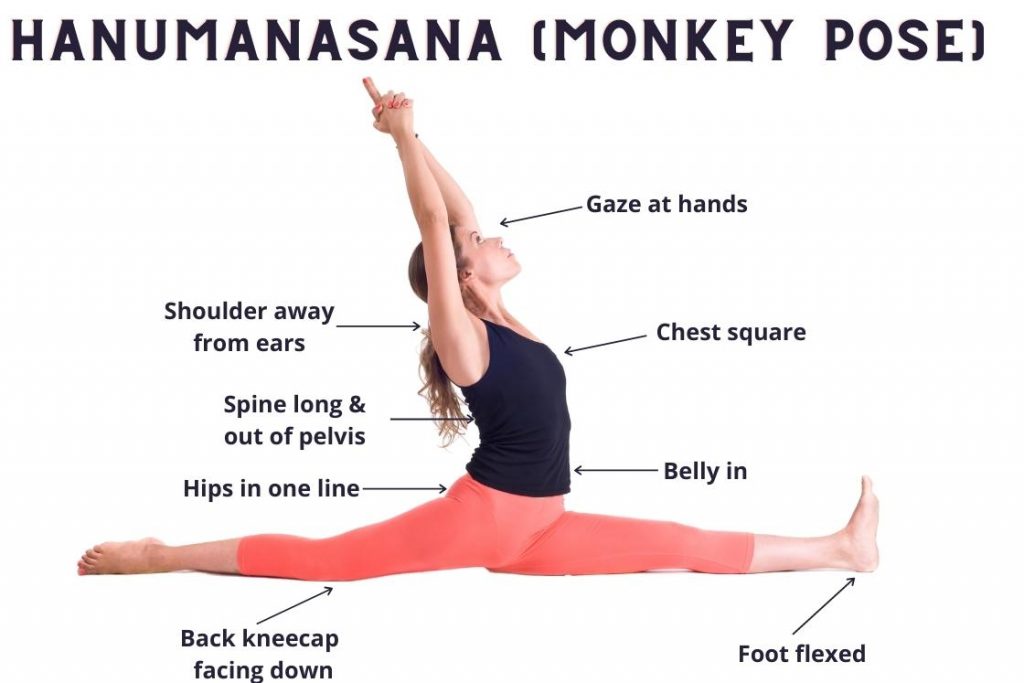
- Begin with kneeling on the left knee, placing the right foot in front of it.
- The gap between the right foot and left knee must be about 30cm.
- Bring the palms to the floor on either side of the right foot.
- Pressing the palms to the floor, slide the right foot forward.
- Straighten both the legs by extending the right foot forward and left foot back as far as possible.
- Both the legs and pelvic region are aligned in a straight line with buttocks reaching the floor.
- Relax the body and bring the hands together in the Anjali mudra pressing against the chest.
- Hold the pose for 30-60 seconds.
- Release the pose and repeat it alternating the leg position.
- Finally, relax extending both the legs forward for one to two minutes.
Follow-up Poses
- Seated Forward Bend (Paschimottanasana)
- One-Legged King Pigeon Pose (Eka Pada Rajakapotasana)
- Wide-Angle Seated Forward Bend (Upavistha Konasana)
- Lord of the Dance Pose (Natarajasana)
Modifications
The splitting action of hanumanasana can be modified using following yoga props;
- Yoga blocks – While performing the hanuman asana place a block on either side of your front foot. Place your hands on the block and then continue stretching the legs. Blocks help to enhance the stretch easily and open the heart, straightening the back muscles. Beginners find it to be the most useful.
- Bolster – Holding the starting position for Hanuman asana, place a bolster between the front foot and back knee. As you straighten, the legs rest the pelvis onto the bolster. It helps to keep the hips square and eases the pose.
- Blanket – Pace a folded blanket under the back knee at the beginning of the pose. Then continue further steps. It will prevent the knee from getting hurt and ease your way to get into the pose.
Monkey Pose Variations
- Monkey Pose (arm variation) – Step up the monkey pose by raising the arms overhead. Bring the palm closer to join them in a prayer pose, fix your gaze to your hands arching the neck.
- Monkey pose Forward Bend
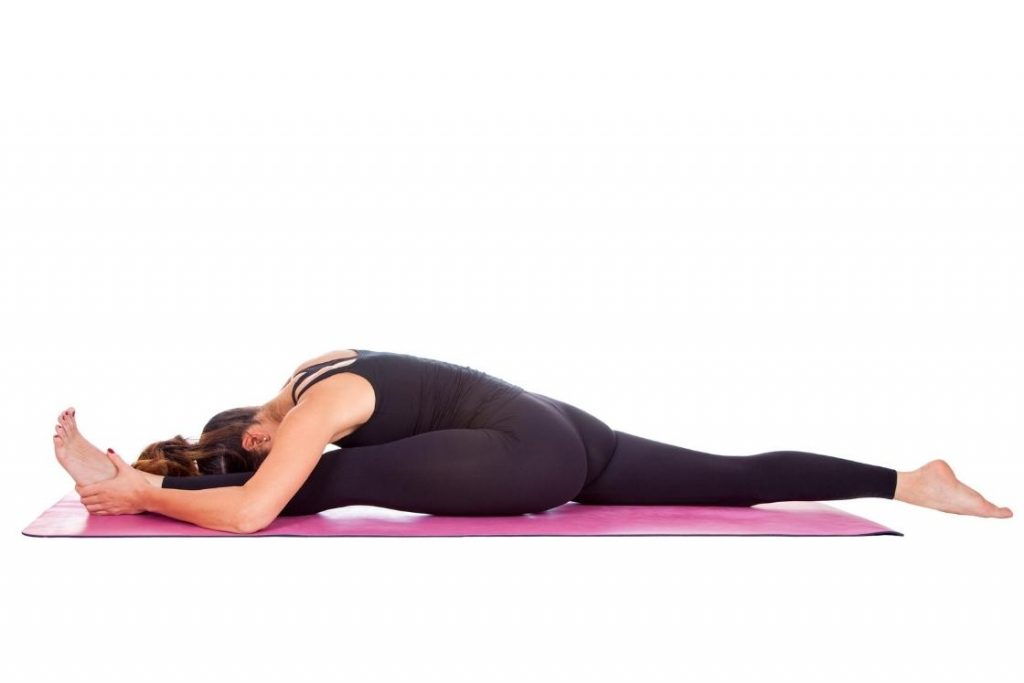
- Come to monkey pose splitting both the legs. Drag your hands and place them on either side of your front foot. Bend forward, bringing the forehead to the front knee and forearm resting on the floor.
- Half Monkey Pose (Ardha hanumanasana)
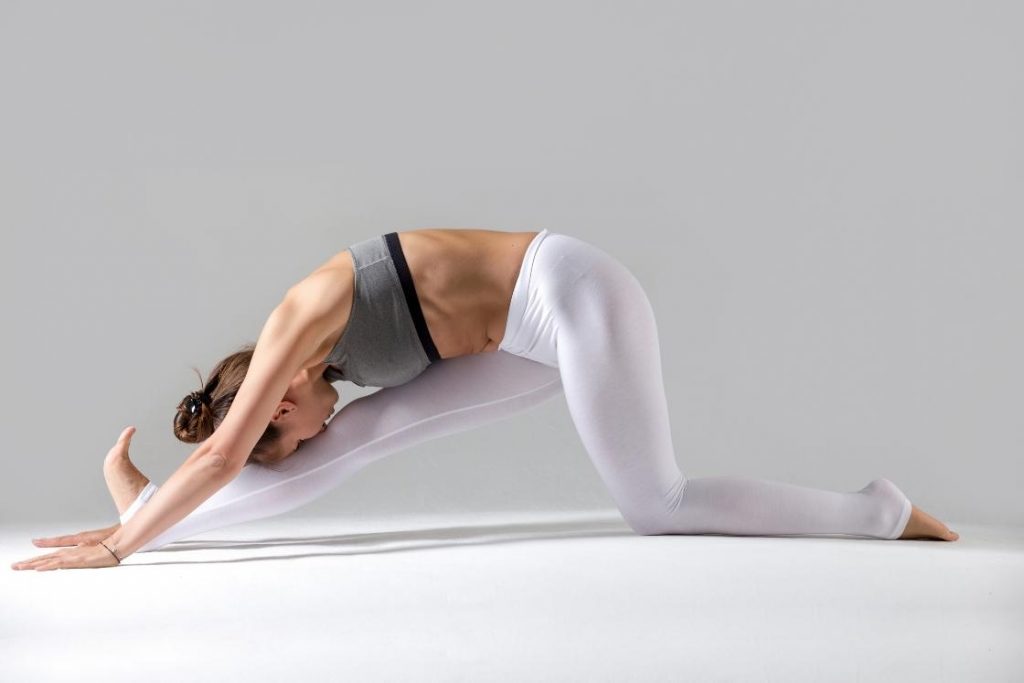
- This is a simple variation of hanuman asana where only one leg is stretched out while another leg remains in the kneeling position.
Begin with kneeling on the left knee and placing the right foot in front of it. Place the palms to the floor on either side of the right foot. Push your hips backward, eventually straightening the right knee. Keep gazing at the floor.
Therapeutic Applications
- Hanumanasana provides a deep stretch to the hip flexors, which can be beneficial for individuals with tight hip flexor muscles.
- The pose engages and stretches the muscles in the lower back. For individuals with mild lower back pain, Hanumanasana, when practiced mindfully and with proper alignment, may contribute to relief and improved flexibility in the lower back.
- The focus on spine integrity and elongation in Monkey Pose can aid in improving overall posture. It encourages the lengthening of the spine and strengthening of the core muscles, which are essential elements for maintaining good posture.
- Hanumanasana involves opening the heart and activating energy centers like the Anahata (Heart) chakra. This can have therapeutic benefits for emotional well-being, promoting a sense of self-love, compassion, and balance.
Hanumanasana(Monkey Pose) Benefits
1. Tones the legs
The full extension of the legs in Hanumanasana strengthens and tones various leg muscles, including the hamstrings, thighs, groins and hip flexors. The pose also stretches and strengthens the calf muscles.
2. Improves spine flexibility
As the legs are fully extended, Hanumanasana promotes the straightening of the upper body and therefore the flexibility of the spine. The stretching of the spinal muscles facilitates the flow of prana from the nostrils to the upper back and thus contributes to the stretching and flexibility of the spine.
3. Improves reproductive health
Engaging the pelvis to support the body weight and maintain balance in Hanumanasana stimulates the reproductive organs. This deep stretch and improved circulation benefit the health of the reproductive organs and make the pose a support for the reproductive system.
4. Stimulates digestive organs
The stretching of the abdominal muscles in Hanumanasana acts like a natural massage for the internal organs. This stimulation increases the efficiency of the digestive organs and promotes better digestion and overall digestive health.
5. Energetic benefits
Hanuman asana also provides spiritual and energetic benefits by activating the Root (Muladhara) chakra, Sacral (Svadhisthana) chakra, and Heart (Anahata) chakra. It develops stability, creativity, and self-love within the practitioner.
Hanumanasana(Monkey Pose) FAQS
While Hanumanasana can be challenging, beginners can start with modifications and gradually work towards the full expression of the pose. It’s important to listen to the body, use props if needed, and progress at a comfortable pace.
Regular stretching, warm-up exercises, and incorporating hip-opening poses in your yoga routine can help improve flexibility for Monkey Pose. Consistent practice, over time, can lead to increased range of motion.
Common mistakes include overextending the front knee, collapsing the chest, or forcing the stretch. It’s crucial to maintain proper alignment, engage core muscles, and avoid pushing the body beyond its limits to prevent injuries.
Hanumanasana can provide relief for some individuals with mild back pain by stretching and strengthening the lower back muscles. However, those with severe back issues should consult with a healthcare professional before attempting the pose.
The duration of holding the pose varies for each individual. Start with a few breaths and gradually increase the duration as you become more comfortable. Listen to your body, and avoid staying in the pose if you feel any pain or discomfort.

